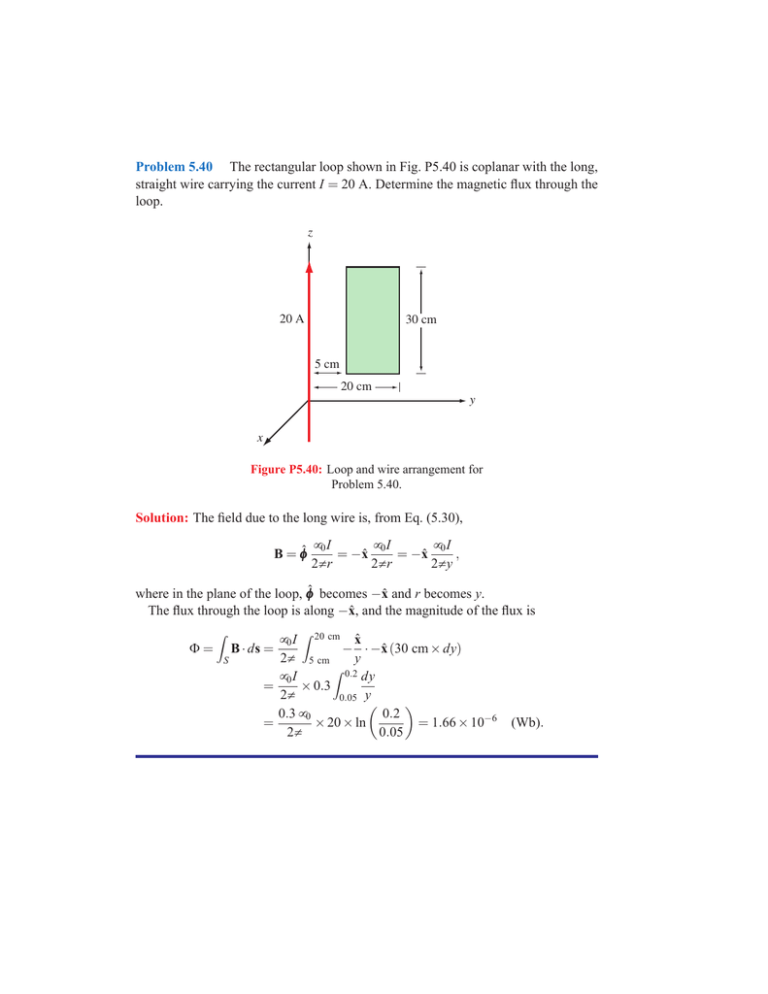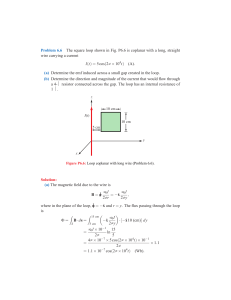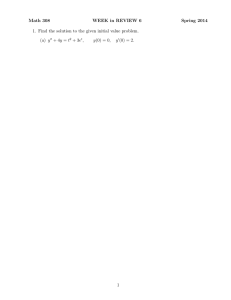Problem 5.40 The rectangular loop shown in Fig. P5.40 is coplanar
advertisement

Problem 5.40 The rectangular loop shown in Fig. P5.40 is coplanar with the long, straight wire carrying the current I = 20 A. Determine the magnetic flux through the loop. z 20 A 30 cm 5 cm 20 cm y x Figure P5.40: Loop and wire arrangement for Problem 5.40. Solution: The field due to the long wire is, from Eq. (5.30), B = φ̂φ µ0 I µ0 I µ0 I = −x̂ = −x̂ , 2π r 2π r 2π y where in the plane of the loop, φ̂φ becomes −x̂ and r becomes y. The flux through the loop is along −x̂, and the magnitude of the flux is µ0 I 20 cm x̂ − · −x̂ (30 cm × dy) Φ = B · ds = 2π 5 cm y S Z 0.2 µ0 I dy = × 0.3 2π 0.05 y ¶ µ 0.3 µ0 0.2 = = 1.66 × 10−6 × 20 × ln 2π 0.05 Z Z (Wb). Problem 6.6 The square loop shown in Fig. P6.6 is coplanar with a long, straight wire carrying a current I(t) = 5 cos(2π × 104t) (A). (a) Determine the emf induced across a small gap created in the loop. (b) Determine the direction and magnitude of the current that would flow through a 4-Ω resistor connected across the gap. The loop has an internal resistance of 1 Ω. z 10 cm I(t) 10 cm 5 cm y x Figure P6.6: Loop coplanar with long wire (Problem 6.6). Solution: (a) The magnetic field due to the wire is B = φ̂φ µ0 I µ0 I = −x̂ , 2π r 2π y where in the plane of the loop, φ̂φ = −x̂ and r = y. The flux passing through the loop is ¶ Z 15 cm µ Z µ0 I −x̂ · [−x̂ 10 (cm)] dy Φ = B · ds = 2π y 5 cm S µ0 I × 10−1 15 ln = 2π 5 4π × 10−7 × 5 cos(2π × 104t) × 10−1 = × 1.1 2π = 1.1 × 10−7 cos(2π × 104t) (Wb). Vemf = − dΦ = 1.1 × 2π × 104 sin(2π × 104t) × 10−7 dt = 6.9 × 10−3 sin(2π × 104t) (V). (b) Iind = Vemf 6.9 × 10−3 = sin(2π × 104t) = 1.38 sin(2π × 104t) (mA). 4+1 5 At t = 0, B is a maximum, it points in −x̂-direction, and since it varies as cos(2π × 104t), it is decreasing. Hence, the induced current has to be CCW when looking down on the loop, as shown in the figure. Problem 6.11 The loop shown in P6.11 moves away from a wire carrying a current I1 = 10 A at a constant velocity u = ŷ7.5 (m/s). If R = 10 Ω and the direction of I2 is as defined in the figure, find I2 as a function of y0 , the distance between the wire and the loop. Ignore the internal resistance of the loop. z 10 cm R u I1 = 10 A I2 20 cm u R y0 Figure P6.11: Moving loop of Problem 6.11. Solution: Assume that the wire carrying current I1 is in the same plane as the loop. The two identical resistors are in series, so I2 = Vemf /2R, where the induced voltage is due to motion of the loop and is given by Eq. (6.26): m Vemf = Vemf = Z (u × B) · dl. n C The magnetic field B is created by the wire carrying I1 . Choosing ẑ to coincide with the direction of I1 , Eq. (5.30) gives the external magnetic field of a long wire to be B = φ̂φ µ0 I1 . 2π r For positive values of y0 in the y-z plane, ŷ = r̂, so × B = r̂|u|× × φ̂φ u × B = ŷ|u|× µ0 I1 µ0 I1 u = ẑ . 2π r 2π r Integrating around the four sides of the loop with dl = ẑ dz and the limits of integration chosen in accordance with the assumed direction of I2 , and recognizing m , we have that only the two sides without the resistors contribute to Vemf ¶¯ ¶¯ Z 0.2 µ Z 0 µ µ0 I1 u ¯¯ µ0 I1 u ¯¯ m Vemf = ẑ · (ẑ dz) · (ẑ dz) + ẑ 2π r ¯r=y0 2π r ¯r=y0 +0.1 0 0.2 µ ¶ 1 4π × 10−7 × 10 × 7.5 × 0.2 1 − = 2π y0 y0 + 0.1 µ ¶ 1 1 = 3 × 10−6 − (V), y0 y0 + 0.1 and therefore µ ¶ m Vemf 1 1 = 150 − I2 = 2R y0 y0 + 0.1 (nA). Problem 6.15 A coaxial capacitor of length l = 6 cm uses an insulating dielectric material with εr = 9. The radii of the cylindrical conductors are 0.5 cm and 1 cm. If the voltage applied across the capacitor is V (t) = 50 sin(120π t) (V) what is the displacement current? Solution: l Id r + V(t) 2a 2b - Figure P6.15: To find the displacement current, we need to know E in the dielectric space between the cylindrical conductors. From Eqs. (4.114) and (4.115), Q , 2πε rl µ ¶ b Q V= ln . 2πε l a E = −r̂ Hence, E = −r̂ D = εE 72.1 50 sin(120π t) V ¡ b ¢ = −r̂ = −r̂ sin(120π t) (V/m), r ln 2 r r ln a = εr ε0 E = −r̂ 9 × 8.85 × 10−12 × 72.1 sin(120π t) r 5.75 × 10−9 sin(120π t) (C/m2 ). r The displacement current flows between the conductors through an imaginary cylindrical surface of length l and radius r. The current flowing from the outer conductor to the inner conductor along −r̂ crosses surface S where = −r̂ S = −r̂ 2π rl. Hence, ∂D ∂ Id = · S = −r̂ ∂t ∂t µ ¶ 5.75 × 10−9 sin(120π t) · (−r̂ 2π rl) r = 5.75 × 10−9 × 120π × 2π l cos(120π t) = 0.82 cos(120π t) (µ A). Alternatively, since the coaxial capacitor is lossless, its displacement current has to be equal to the conduction current flowing through the wires connected to the voltage sources. The capacitance of a coaxial capacitor is given by (4.116) as C= The current is I =C 2πε l ¡ ¢. ln ba 2πε l dV = ¡ b ¢ [120π × 50 cos(120π t)] = 0.82 cos(120π t) (µ A), dt ln a which is the same answer we obtained before. Problem 6.16 The parallel-plate capacitor shown in Fig. P6.16 is filled with a lossy dielectric material of relative permittivity εr and conductivity σ . The separation between the plates is d and each plate is of area A. The capacitor is connected to a time-varying voltage source V (t). I A V(t) ε, σ d Figure P6.16: Parallel-plate capacitor containing a lossy dielectric material (Problem 6.16). (a) Obtain an expression for Ic , the conduction current flowing between the plates inside the capacitor, in terms of the given quantities. (b) Obtain an expression for Id , the displacement current flowing inside the capacitor. (c) Based on your expressions for parts (a) and (b), give an equivalent-circuit representation for the capacitor. (d) Evaluate the values of the circuit elements for A = 4 cm2 , d = 0.5 cm, εr = 4, σ = 2.5 (S/m), and V (t) = 10 cos(3π × 103t) (V). Solution: (a) R= (b) d , σA Ic = V VσA = . R d ∂D ∂ E εA ∂V V , Id = · A = εA = . d ∂t ∂t d ∂t (c) The conduction current is directly proportional to V , as characteristic of a resistor, whereas the displacement current varies as ∂ V/∂ t, which is characteristic E= of a capacitor. Hence, R= d σA C= and εA . d I + ε, σ V(t) R Ic Id + C V(t) - - Actual Circuit Equivalent Circuit Figure P6.16: (a) Equivalent circuit. (d) 0.5 × 10−2 = 5 Ω, 2.5 × 4 × 10−4 4 × 8.85 × 10−12 × 4 × 10−4 = 2.84 × 10−12 F. C= 0.5 × 10−2 R=



